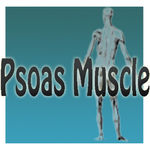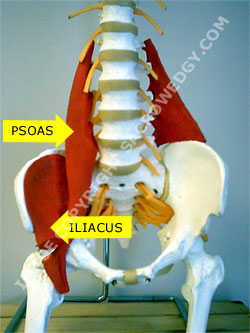The Psoas Muscle 

According to Trail Guide to the Body: "The iliacus and psoas major, together called the iliopsoas, are major hip flexors. The long, slender psoas major is located deep to the abdominal contents and stretches from the lumbar vertebrae to the lesser trochanter. The stocky iliacus is located deep to the abdomen in the iliac fossa."
Because of the location of these muscles, they are hard to access. This is where relaxing on the Sacro Wedgy® has great benefit. With the sacrum in a neutral, elevated position, the hips are now slightly suspended and free to relax. As the body weight now has a slight natural traction effect, these muscles stand a much better chance of relaxing and eventually releasing and re-balancing. Often when the psoas is too tight and short on one side it will begin pulling on the spinal column in the lumbar, as that is where it attaches.
Once that torquing begins, there will be names given to the symptoms this tightness creates. A therapist can now access the psoas much easier by pulsing it from the insertion point or top of the thigh as opposed to trying to palpate internally. The iliacus and psoas attach in the same area so stretching one point stretches both muscles. Gravity will eventually do most of the work by simply allowing the body to relax.
Although it is important to relax the tight side of the body it is of equal importance that the weak side of the body is given even more attention. For instance if one leg drags forward slower that the other side and since the psoas is responsible for picking up the leg, that would be the weaker side and the best way to strengthen it is our series of isometrics for 2 or 3 weeks. Relax the shorter strong side, strengthen the longer weak side. The short psoas pulls the hip higher giving the ilusion of a short leg when it may be a higher hip. A snowball effect has really been created when one muscle effects the balance of another.
Pelvic floor dysfunction
Pelvic floor dysfunction (PFD) refers to a wide range of issues that occur when muscles of the pelvic floor are weak, tight, or there is an impairment of the sacroiliac joint, lower back, coccyx, or hip joints. Symptoms include pelvic pain, pressure, dyspareunia, incontinence, incomplete emptying, and gross organ protrusion. Tissues surrounding the pelvic organs may have increased or decreased sensitivity or irritation resulting in pelvic pain. Many times, the underlying cause of pelvic pain is difficult to determine. The condition affects up to 50% of women
The Sacro Wedgy® may very well be a great way to help control or correct some of these symptoms. The psoas muscle is so involved with the pelvic floor that if there is the slightest difference in the balance of the psoas there could be some pulling and a torque of the pelvic girdle creating a lot of these symptoms. Relaxing on the Sacro Wedgy® holds the sacrum in a neutral position allowing surrounding muscles the freedom to release. Also, some of the routines included in the Sacro Wedgy® protocol are very beneficial in relaxing and helping to balance the psoas. The pelvic tilt while on the Sacro Wedgy® is especially helpful and should always be done at the end of a session. |
